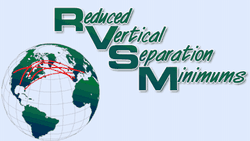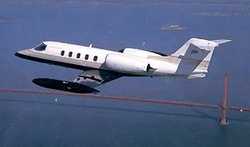Mon, Jan 24, 2005
An ANN Reader Talks About The Downside of RVSM
By Mark Conner, Chief Pilot, Dycom Industries, Inc.
 Most corporate operators see this as
a winning move for the airlines and a financial burden to us. True
that the airlines will save money by cruising at more efficient
altitudes but the cost to my corporation is significant with little
reward.
Most corporate operators see this as
a winning move for the airlines and a financial burden to us. True
that the airlines will save money by cruising at more efficient
altitudes but the cost to my corporation is significant with little
reward.
The cost to conform our late model LearJet 35A was over $180,000 in
direct cost. If one includes the cost of nearly a month of downtime
for the modification, that number might easily be doubled. We
will see little if any reward as our cruise is usually above
RVSM altitudes. Moreover, the FAA placed a huge burden on part 91
operators to submit a manual covering operations and maintenance
procedures. This should have been covered by the SCT's continued
airworthiness instructions and a new FAR 91 regulation covering
RVSM operations. This time and expense to small flight department
is not insignificant.
 Many turboprop operators have chosen
not to spend the money to modify their aircraft. They will now be
forced to operate at inefficient altitudes. Moreover, the weather
they used to top will now force either a circumnavigation or a
cancellation of the flight. This hurts general aviation as it makes
planes more expensive to own, or operate and reduces the utility of
a huge number of planes.
Many turboprop operators have chosen
not to spend the money to modify their aircraft. They will now be
forced to operate at inefficient altitudes. Moreover, the weather
they used to top will now force either a circumnavigation or a
cancellation of the flight. This hurts general aviation as it makes
planes more expensive to own, or operate and reduces the utility of
a huge number of planes.
Many operators of older jets have found conformity to RVSM cost
prohibitive. There is a whole generation of older LearJets,
Citations, Hawkers, and Saberliners that will be doomed. Their
values have steadily dropped and operating costs have risen due to
high fuel flows. For example, older Lear 24 can be had for little
more than the price of a good Navajo with an operating cost over
$1500 per hour. This made them ideal for owners who operated
infrequently and were willing to foot the bill for fuel as long as
they didn't have to face a multimillion-dollar debt service. These
planes are destined to be sold to third world countries for little
more than their salvage values.

RVSM has not been a friend to General Aviation. It is yet
another move toward the restrictive type of airspace that plagues
Europe. I cannot help but ask how long until the rest of General
Aviation is as restricted and costly as it is now in Europe. How
long before legislators, in the name of national security and
airline profitability, add the next level of bricks on the tomb of
General Aviation?
More News
Aero Linx: Transport Canada We are a federal institution, leading the Transport Canada portfolio and working with our partners. Transport Canada is responsible for transportation p>[...]
Gross Navigation Error (GNE) A lateral deviation from a cleared track, normally in excess of 25 Nautical Miles (NM). More stringent standards (for example, 10NM in some parts of th>[...]
From AirVenture 2017 (YouTube Edition): Flight-Proven Booster On Display At AirVenture… EAA AirVenture Oshkosh is known primarily as a celebration of experimental and amateu>[...]
Aircraft Parachute System (CAPS) Was Deployed About 293 Ft Above Ground Level, Which Was Too Low To Allow For Full Deployment Of The Parachute System Analysis: The day before the a>[...]
Also: 48th Annual Air Race Classic, Hot Air Balloon Fire, FAA v Banning 100LL, Complete Remote Pilot The news Piper PA-18 Super Cub owners have been waiting for has finally arrived>[...]
 ANN's Daily Aero-Linx (06.29.25)
ANN's Daily Aero-Linx (06.29.25) ANN's Daily Aero-Term (06.29.25): Gross Navigation Error (GNE)
ANN's Daily Aero-Term (06.29.25): Gross Navigation Error (GNE) Classic Aero-TV: Anticipating Futurespace - Blue Origin Visits Airventure 2017
Classic Aero-TV: Anticipating Futurespace - Blue Origin Visits Airventure 2017 NTSB Final Report: Cirrus SR22
NTSB Final Report: Cirrus SR22 Airborne Affordable Flyers 06.26.25: PA18 Upgrades, Delta Force, Rhinebeck
Airborne Affordable Flyers 06.26.25: PA18 Upgrades, Delta Force, Rhinebeck





